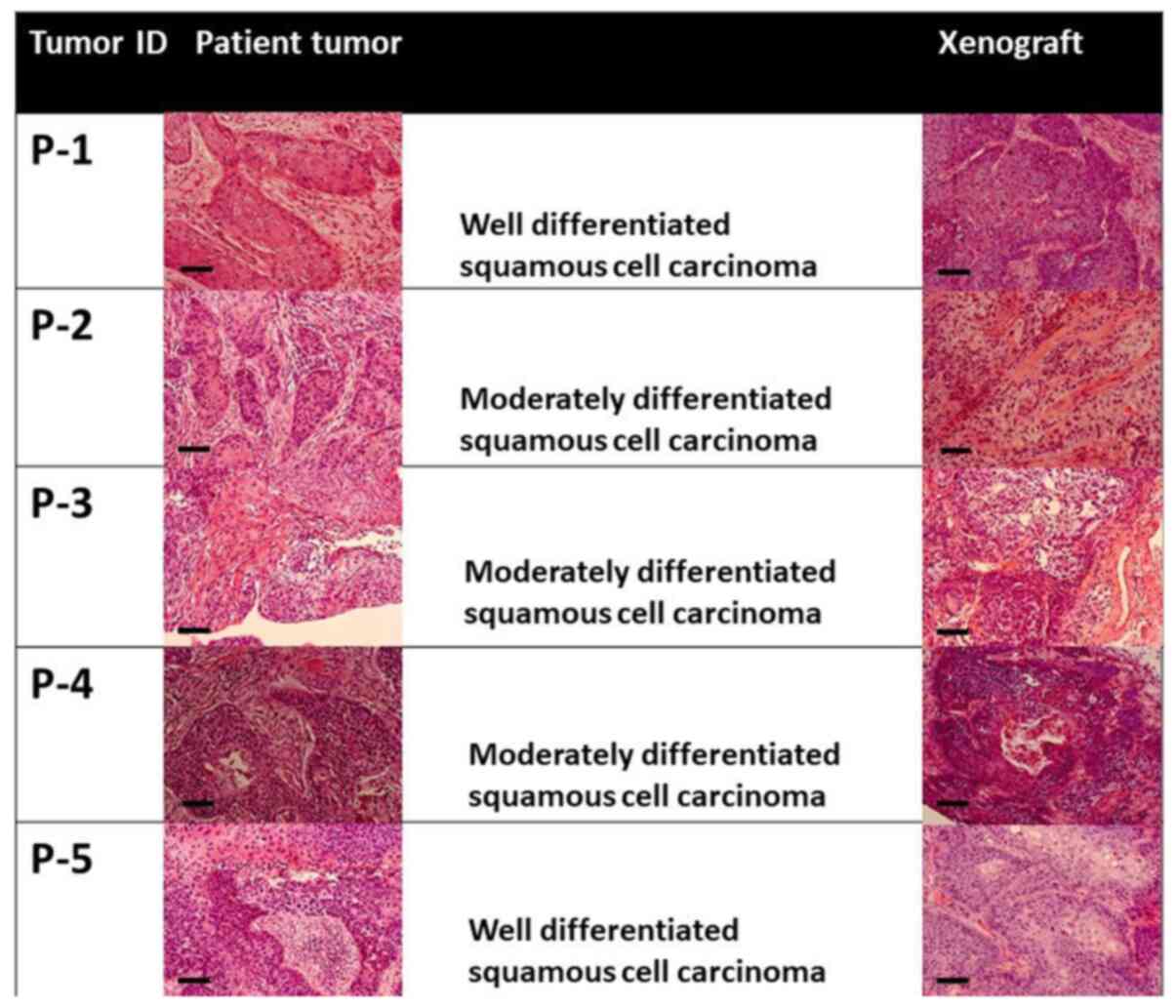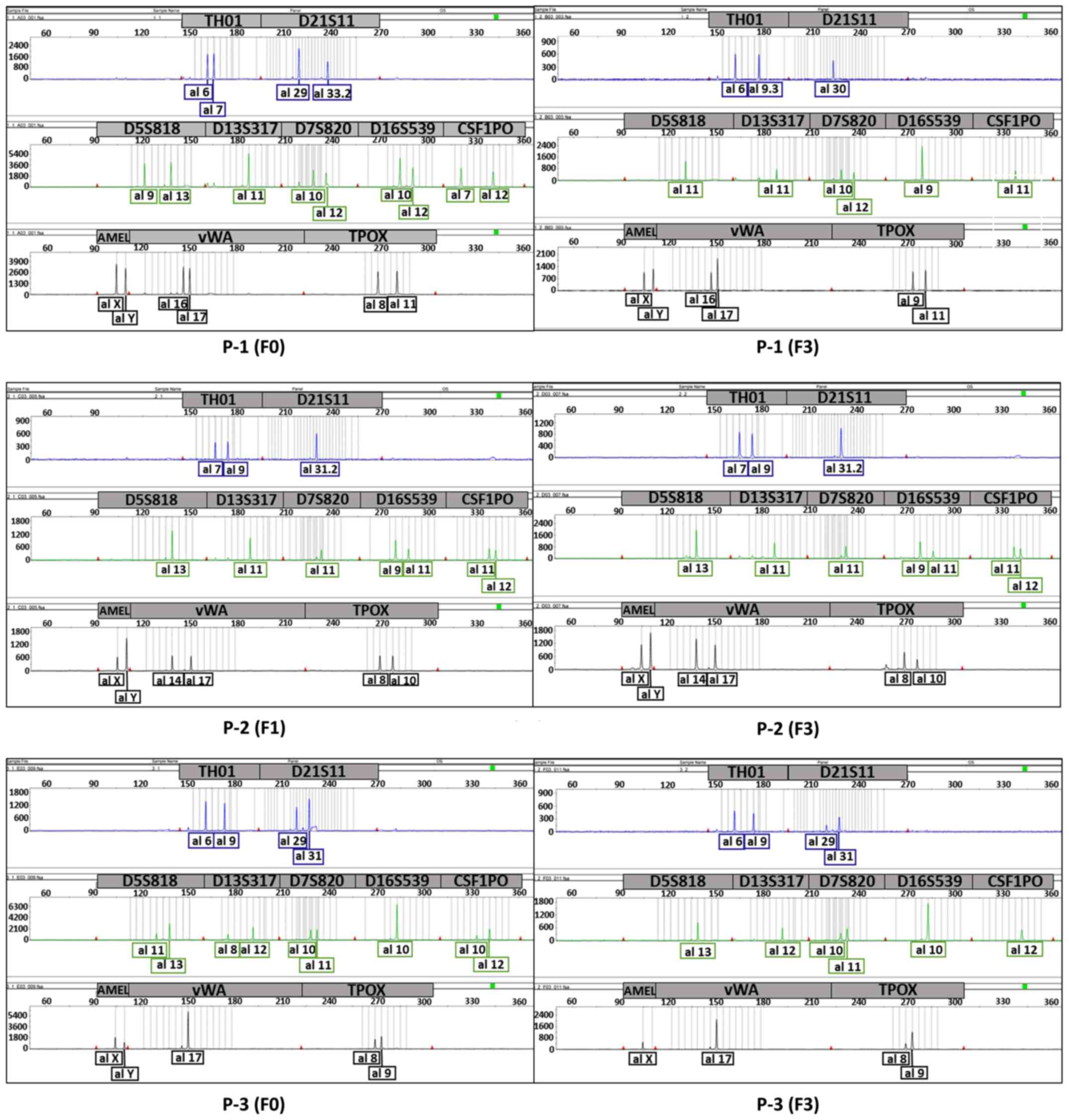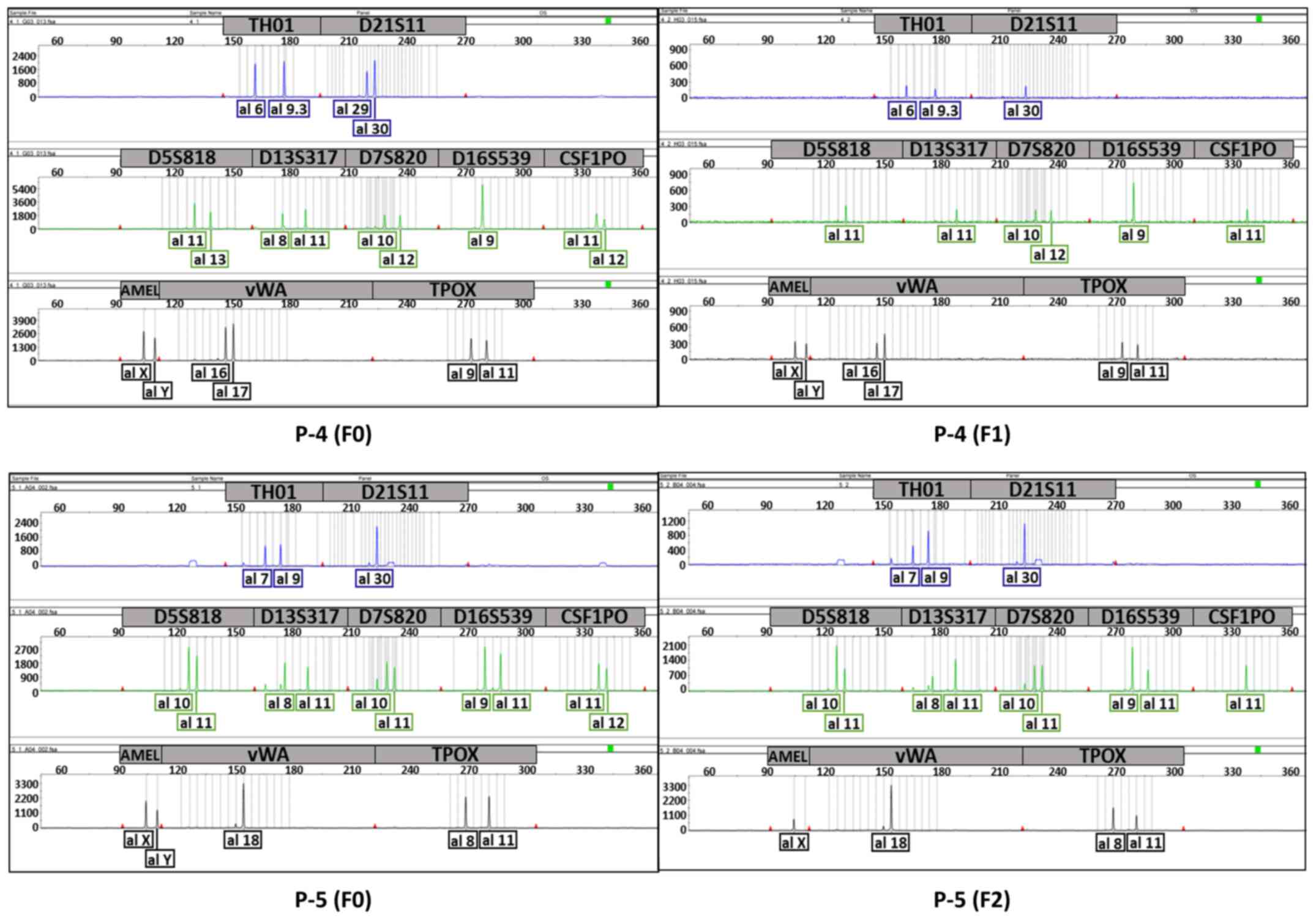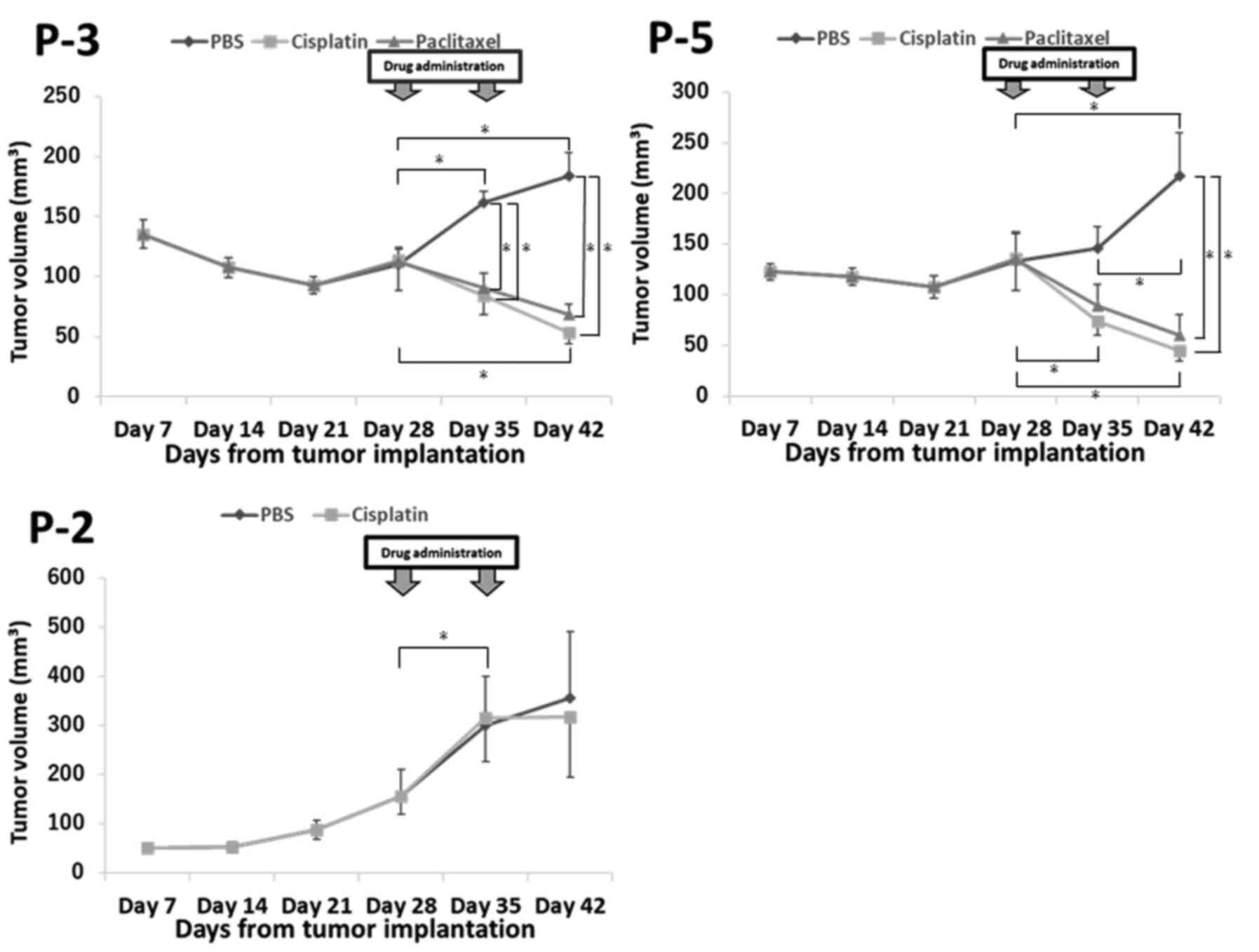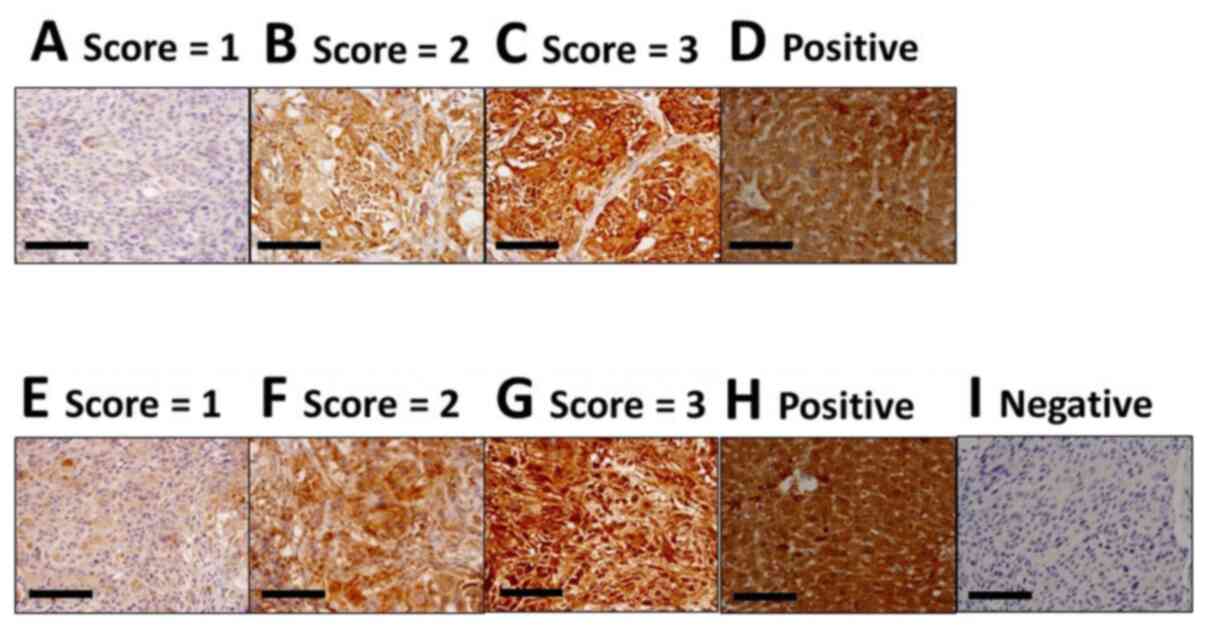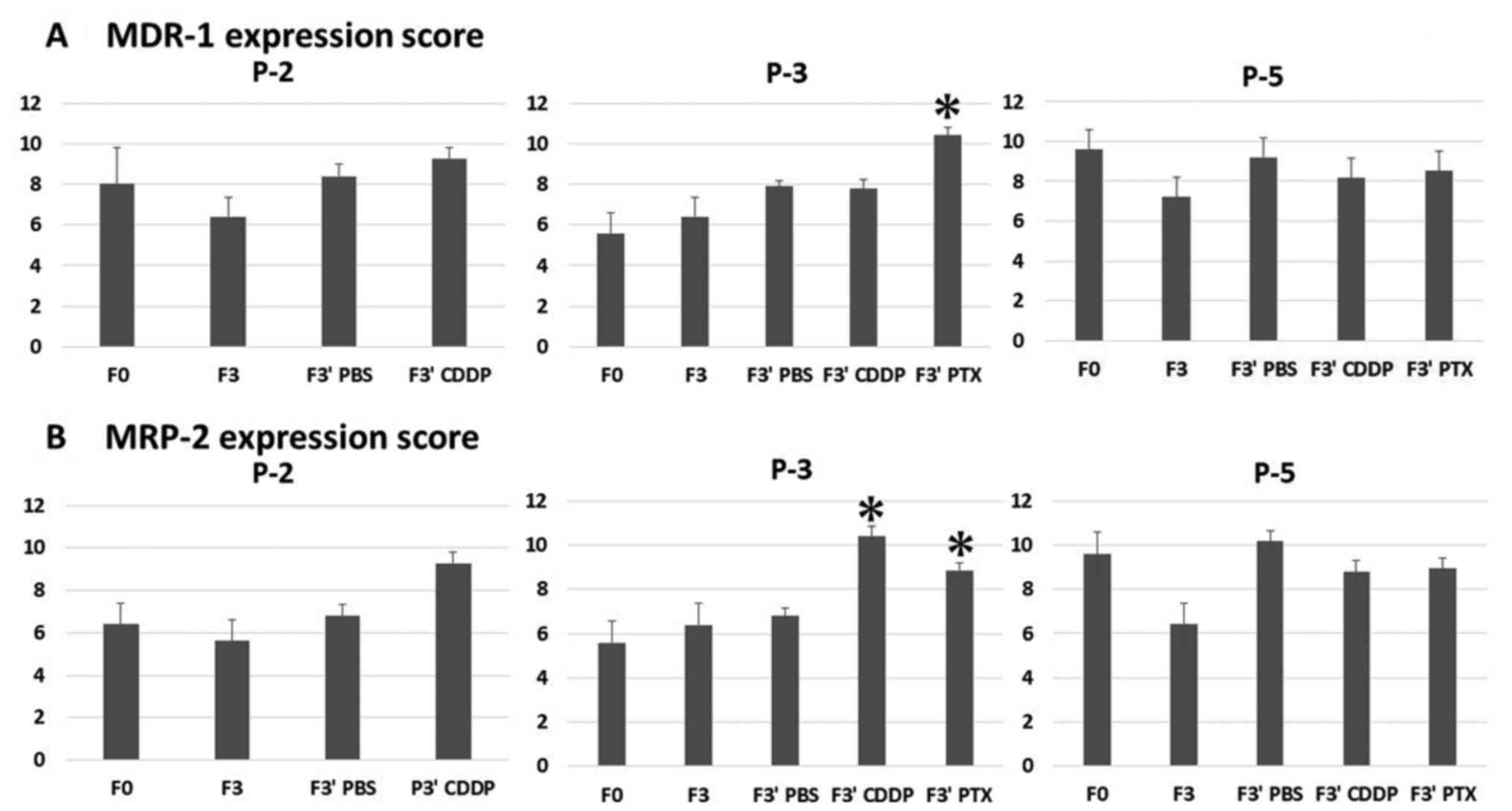|
1
|
DiMasi JA, Reichert JM, Feldman L and
Malins A: Clinical approval success rates for investigational
cancer drugs. Clin Pharmacol Ther. 94:329–335. 2013. View Article : Google Scholar : PubMed/NCBI
|
|
2
|
Jung J, Seol HS and Chang S: The
generation and application of patient-derived xenograft model for
cancer research. Cancer Res Treat. 50:1–10. 2018. View Article : Google Scholar : PubMed/NCBI
|
|
3
|
Peng S, Creighton CJ, Zhang Y, Sen B,
Mazumdar T, Myers JN, Lai SY, Woolfson A, Lorenzi MV, Bell D, et
al: Tumor grafts derived from patients with head and neck squamous
carcinoma authentically maintain the molecular and histologic
characteristics of human cancers. J Transl Med. 11:1982013.
View Article : Google Scholar : PubMed/NCBI
|
|
4
|
Vrana D, Hlavac V, Brynychova V,
Vaclavikova R, Neoral C, Vrba J, Aujesky R, Matzenauer M, Melichar
B and Soucek P: ABC transporters and their role in the neoadjuvant
treatment of esophageal cancer. Int J Mol Sci. 19:8682018.
View Article : Google Scholar
|
|
5
|
Theile D, Gal Z, Warta R, Rigalli JP,
Lahrmann B, Grabe N, Herold Mende C, Dyckhoff G and Weiss J:
Antiproliferative efficacies but minor drug transporter inducing
effects of paclitaxel, cisplatin, or 5-fluorourcil in a murine
xenograft model for head and neck squamous cell carcinoma. Cancer
Biol Ther. 15:436–442. 2014. View Article : Google Scholar : PubMed/NCBI
|
|
6
|
Warta R, Theile D, Mogler C, Herpel E,
Grabe N, Lahrmann B, Plinkert PK, Herolde-Mende C, Weiss J and
Dyckhoff G: Association of drug transporter expression with
mortality and progression-free survival in stage IV head and neck
squamous cell carcinoma. PLos One. 9:e1089082014. View Article : Google Scholar : PubMed/NCBI
|
|
7
|
Brierley JD, Gospodarowicz MK and
Wittekind C: UICC TNM Classification of Malignant Tumours. 8th
edition. Wiley Blackwell; New York, NY: 2017
|
|
8
|
Tanabe H, Takada Y, Minegishi D, Kurematsu
M, Masui T and Mizusawa H: Cell line individualization by STR
multiplex system in the cell bank found cross-contamination between
ECV304 and EJ-1/T24. Tiss Cult Res Commun. 18:329–338. 1999.
|
|
9
|
Cho YB, Hong HK, Choi YL, Oh E, Joo KM,
Jin J, Nam DH, Ko YH and Lee WY: Colorectal cancer patient-derived
xenografted tumors maintain characteristic features of the original
tumors. J Surg Res. 187:502–509. 2014. View Article : Google Scholar : PubMed/NCBI
|
|
10
|
Klinghammmer K, Raguse JD, Plath T, Albers
AE, Joehrens K, Zakameh A, Brzezicha B, Wulf-Goldenberg A, Keilholz
U, Hoffmann J and Fichtner I: A comprehensively characterized large
panel of head and neck cancer patient-derived xenografts identifies
the mTOR inhibitor everolimus as potential new treatment option.
Int J Cancer. 136:2940–2948. 2015. View Article : Google Scholar : PubMed/NCBI
|
|
11
|
Kimple RJ, Harari PM, Torres AD, Yang RZ,
Soriano BJ, Yu M, Armstrong EA, Blitzer GC, Smith MA, Lorenz LD, et
al: Development and characterization of HPV-positive and
HPV-negative head and neck squamous cell carcinoma tumorgrafts.
Clin Cancer Res. 19:855–864. 2013. View Article : Google Scholar : PubMed/NCBI
|
|
12
|
Stewart EL, Mascaux C, Pham NA, Sakashita
S, Sykes J, Kim L, Yanagawa N, Allo G, Ishizawa K, Wang D, et al:
Clinical utility of patient-derived xenografts to determine
biomarkers of prognosis and map resistance pathways in EGFR-mutant
lung adenocarcinoma. J Clin Oncol. 33:2472–2480. 2015. View Article : Google Scholar : PubMed/NCBI
|
|
13
|
Garrido-Laguna I, Uson M, Rajeshkumar NV,
Tan AC, de Oliveira E, Karikari C, Villaroel MC, Salomon A, Taylor
G, Sharma R, et al: Tumor engraftment in nude mice and enrichment
in stroma-related gene pathways predicts poor survival and
resistance to gemcitabine in patients with pancreatic cancer. Clin
Cancer Res. 17:5793–5800. 2011. View Article : Google Scholar : PubMed/NCBI
|
|
14
|
Pergolini I, Morales-Oyarvide V,
Mino-Kenudson M, Honselmann KC, Rosenbaum MW, Nahar S, Kem M,
Ferrone CR, Lillemoe KD, Bardeesy N, et al: Tumor engraftment in
patient-derived xenografts of pancreatic ductal adenocarcinoma is
associated with adverse clinicopathological features and poor
survival. PLoS One. 12:e01828552017. View Article : Google Scholar : PubMed/NCBI
|
|
15
|
Facompre ND, Sahu V, Montone KT, Harmeyer
KM, Nakagawa H, Rustgi AK, Weinstein GS, Gimotty PA and Basu D:
Barriers to generating PDX models of HPV-related head and neck
cancer. Laryngoscope. 127:2777–2783. 2017. View Article : Google Scholar : PubMed/NCBI
|
|
16
|
Prince ME, Sivanandan R, Kaczorowski A,
Wolf GT, Kaplan MJ, Dalerba P, Weissman IL, Clarke MF and Ailles
LE: Identification of a subpopulation of cells with cancer stem
cell properties in head and neck squamous cell carcinoma. Proc Natl
Acad Sci USA. 104:973–978. 2007. View Article : Google Scholar : PubMed/NCBI
|
|
17
|
Yu J, Qin B, Moyer AM, Sinnwell JP,
Thompson KJ, Copland JA III, Marlow LA, Miller JL, Yin P, Gao B, et
al: Establishing and characterizing patient-derived xenografts
using pre-chemotherapy percutaneous biopsy and post-chemotherapy
surgical samples from a prospective neoadjuvant breast cancer
study. Breast Cancer Res. 19:1302017. View Article : Google Scholar : PubMed/NCBI
|
|
18
|
Markman M, Rothman R, Hakes T, Reichman B,
Hoskins W, Rubin S, Jones W, Almadrones L and Lewis JL Jr:
Second-line platinum therapy in patients with ovarian cancer
previously treated with cisplatin. J Clin Oncol. 9:389–393. 1991.
View Article : Google Scholar : PubMed/NCBI
|
|
19
|
Harries M and Gore M: Part II:
chemotherapy for epithelial ovarian cancer-treatment of recurrent
disease. Lancet Oncol. 3:537–545. 2002. View Article : Google Scholar : PubMed/NCBI
|
|
20
|
Knoedler M, Gauler TC, Gruenwald V,
Matzdorff A, Schroeder M, Dietz A, Jordan WO, Arnold D, Hennemann
B, Hofele C, et al: Phase II study of cetuximab in combination with
docetaxel in patients with recurrent and/or metastatic squamous
cell carcinoma of the head and neck after platinum-containing
therapy: A multicenter study of the Arbeitsgemeinschaft
Internistische Onkologie. Oncology. 84:284–289. 2013. View Article : Google Scholar : PubMed/NCBI
|
|
21
|
Das Thakur M, Salangsang F, Landman AS,
Sellers WR, Pryer NK, Levesque MP, Dummer R, McMahon M and Stuart
DD: Modelling vemurafenib resistance in melanoma reveals a strategy
to forestall drug resistance. Nature. 494:251–255. 2013. View Article : Google Scholar : PubMed/NCBI
|















